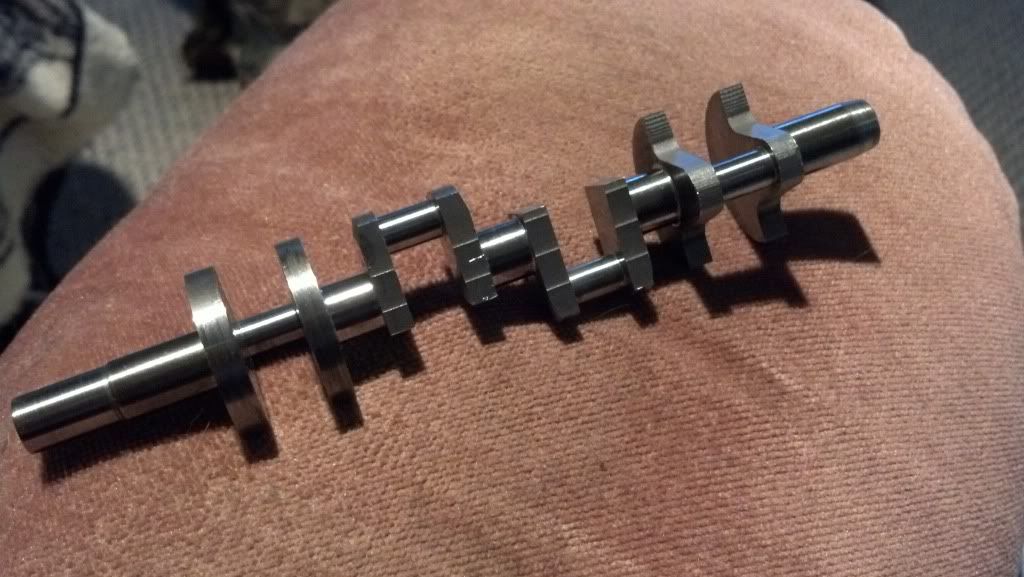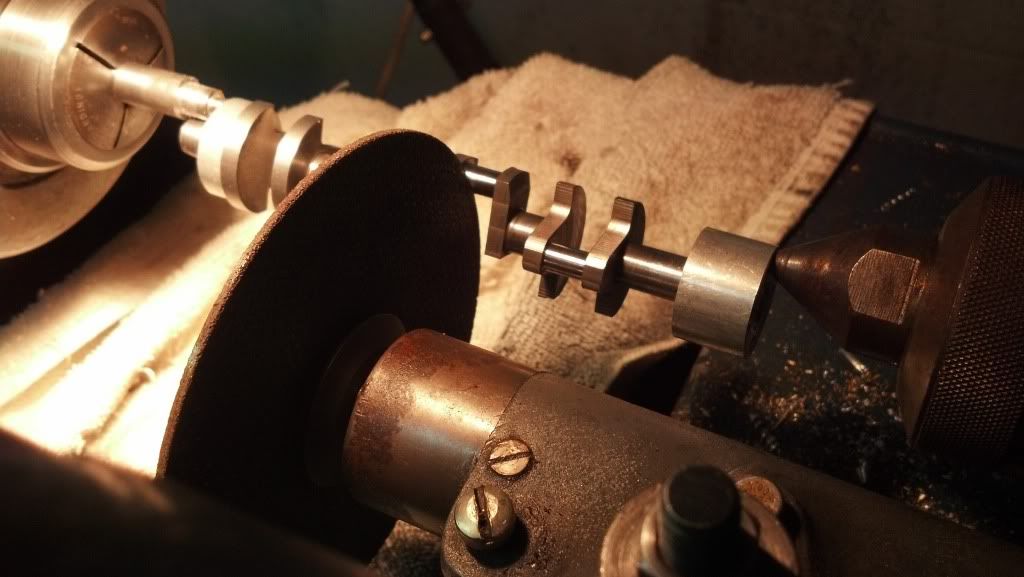You are using an out of date browser. It may not display this or other websites correctly.
You should upgrade or use an alternative browser.
You should upgrade or use an alternative browser.
Jim builds his second v-8
- Thread starter jpeter
- Start date

Help Support Home Model Engine Machinist Forum:
This site may earn a commission from merchant affiliate
links, including eBay, Amazon, and others.
Looks like a little bit of work to do there, what were the rods made out of?
Aluminum.
Think maybe the sleeves, pistons and rings are ok.
I got an earlier v8 I've been running for a long while, 5 gallons of fuel or more. It's built the same way and running nicely. Always ran it though on premix. On this one I depended on the splash system. Gotta rethink my that. Pretty convinced my dipstick was giving false readings. Foolproof as it is I think oil was getting up in the tube and showing oil when there was none. It went south pretty quickly. Read oil in the pan up to the mark but I disassembled it carefully to see what was really in it and the actual amount was pretty low, aluminum mud mostly.
That sucks!
You betcha.:wall:
Last edited:
Lakc
Well-Known Member
Usually the rods are 70 series aluminum. I asked because it looked like the wear I had seen on some mushy aluminum I used once.
If the crankpins lived that skinny then clean them up and modify the print for the replacement rods. Nobody will know but us and we wont tell
If the crankpins lived that skinny then clean them up and modify the print for the replacement rods. Nobody will know but us and we wont tell
Usually the rods are 70 series aluminum. I asked because it looked like the wear I had seen on some mushy aluminum I used once.
If the crankpins lived that skinny then clean them up and modify the print for the replacement rods. Nobody will know but us and we wont tell
Good idea. Rods were from plate I picked up at the scrap yard. I don't really know the analyses. I outta pick up some better material for the second run.

$39.99
$49.99
Sunnytech Low Temperature Stirling Engine Motor Steam Heat Education Model Toy Kit For mechanical skills (LT001)
stirlingtechonline

$45.99
Sunnytech Mini Hot Air Stirling Engine Motor Model Educational Toy Kits Electricity HA001
stirlingtechonline

$25.34
$34.99
Bowl Sander Tool Kit w/Dual Bearing Head & Hardwood Handle | 42PC Wood Sander Set | 2" Hook & Loop Sanding Disc Sandpaper Assortment | 1/4" Mandrel Bowl Sander for Woodturning | Wood Lathe Tools
Peachtree Woodworking Supply Inc

$18.90
$22.90
Woodturning Double Ended Bowl Calipers Stainless Steel 11Inch Woodworking Caliper Tools
sdltools
Were there any bearings on those big ends? I would think some bronze oilite bearings might help prevent any disasters like this from happening in the future.
Bronze bushings and shells on the mains.
Art K
Well-Known Member
- Joined
- Jul 4, 2012
- Messages
- 218
- Reaction score
- 39
Jim,
I was gone for the weekend and came back to find this:wall:, it sucks. I remember back when I was a kid it was me and my brothers responsibility to keep the cars full of oil. My dad would wonder why the oil light was going on around corners and up hills, checked the oil when he got home and it was 3 quarts low. Needless to say we filled it immediately no matter the time. Time for a new oil level gauge.
Art
I was gone for the weekend and came back to find this:wall:, it sucks. I remember back when I was a kid it was me and my brothers responsibility to keep the cars full of oil. My dad would wonder why the oil light was going on around corners and up hills, checked the oil when he got home and it was 3 quarts low. Needless to say we filled it immediately no matter the time. Time for a new oil level gauge.
Art
Man that must hurt! I feel for ya.
Instead of a beer how about a cheap or free local car/air show, that will brighten your day. Just came from a local airshow and I can't tell you the aviation hangover I'm having (In a very good way.)!
Cheers,
John.
Instead of a beer how about a cheap or free local car/air show, that will brighten your day. Just came from a local airshow and I can't tell you the aviation hangover I'm having (In a very good way.)!
Cheers,
John.
Got all bearing surfaces resurfaced. I have a Dumore toolpost grinder. I have a hard time finding wheels large enough to do a crank so I've resigned to using cut-off wheels designed for angle grinders. The one I used on this job is an A46 grit 1/16 inch wide. I dress it of course with a diamond dresser. I belt the grinder to spin it about 8,000 rpm. That might involve a #3 & 4 pulley but then again maybe not. Anyway, it's a slick way to get a nice finish on a wear surface.


Last edited:
Lakc
Well-Known Member
Very pretty.
Finding the right size wheel is difficult, best possible size I have found is 7"x 1/4". Then I need to build the crankshaft grinder around that size.
You seem to be doing excellent work with what you have, however.
Finding the right size wheel is difficult, best possible size I have found is 7"x 1/4". Then I need to build the crankshaft grinder around that size.
You seem to be doing excellent work with what you have, however.
Fix'n up the old crank. Gonna have to make some non-standard bushings.
It's your design so I think what you meant was you were going to have to use the other standard bearings.
For a rough pass I infeed about 0.005 pretty darn slow, maybe 10 seconds. I hand feed really slow too so it's time consuming. I sneak in a thou or two for the finish pass. I then make a pass or two with no infeed to let it "spark out."WOW at that right there! How much are you taking per pass?
For a rough pass I infeed about 0.005 pretty darn slow, maybe 10 seconds. I hand feed really slow too so it's time consuming. I sneak in a thou or two for the finish pass. I then make a pass or two with no infeed to let it "spark out."
That's a hefty cut on a grinder... but the wheel is very narrow.
Very pretty.
Finding the right size wheel is difficult, best possible size I have found is 7"x 1/4". Then I need to build the crankshaft grinder around that size.
You seem to be doing excellent work with what you have, however.
Doubt I have enough power and speed reduction for a wheel that large. At work I had a tool and cutter grinder that used 7 inch wheels. My spindle is 3/8 inch dia. I made a bushing 3/8 to 7/8 for the cut-off wheels. I think 4 inch wheels max it out.
0.005 is a heavy cut maybe too heavy but the machine seems to take it well enough and yeah, the wheel is thin. I'm sure that helps a lot too. Don't knock it till you try it.
Last edited:
Lakc
Well-Known Member
I have never done any machine grinding so I am no authority. You seem to be getting along well with what you have.
When I come up with a pair of chucks and a copy of machine tool reconditioning, I will be ready to put something on paper, but a dedicated crankshaft grinder could probably get some use in this area.
What rpm are you spinning the crankshaft at?
When I come up with a pair of chucks and a copy of machine tool reconditioning, I will be ready to put something on paper, but a dedicated crankshaft grinder could probably get some use in this area.
What rpm are you spinning the crankshaft at?
...What rpm are you spinning the crankshaft at?
I spin it slow as I can go, in reverse too. I have a Sheldon with variable speed drive. I think 150 rpm would be close. I misled you on the depth cuz my lathe cross feed reads in diameters. I really cut only 2.5 mill dp but reduce the diameter by 5 thou. That's quite a difference when grinding.
Similar threads
- Replies
- 2
- Views
- 1K




















